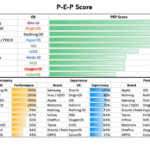Before delving more in to this topic, let’s examine the premium segment for Android smartphones. Not much has changed in over a decade for the premium segment for Android powered smartphone OEMs in India. The scenario I had pictured in this writeup almost 10 years back is very much the same.
Somewhere we miss this fundamental pattern of Google’s Android consistently failing to deliver the experience that could match that of Apple’s iOS. Despite all inherent challenges posed to the OEMs having focus in the premium and ultra-premium layers of the market, they have done a remarkable job over these years in making their offerings comparable on many fronts to that of the iPhone, which by far remains the benchmark not only for this segment but also continues to be a trendsetter in many ways that inspires OEMs across the board to follow the pursuits.
Within OEMs powered by Android that includes Samsung, OnePlus and now Vivo, they have been attempting to bring premium experiences by way of pioneering newer form-factors like the foldable smartphones, investing a lot in camera performance, and addressing other concerns of this cohort of users, primary being privacy and security. Samsung has developed an additional shield in the form of Knoxx while others also have brought in elements of security and privacy. OnePlus has a dedicated chip for security and privacy that helps it achieve EAL5+ level of international standards.
On the camera front, Samsung has developed one of the best camera capabilities that features in its S and Z series of lineup serving the premium and ultra-premium customers. Similarly, both vivo and OnePlus have collaborated with very credible global names in the camera and photography industry. Vivo also has developed a dedicated chip for camera performance.
Samsung and to some extent OnePlus have also developed a complete ecosystem of devices for premium tier customers who get a seamless experience while staying within these OEM led micro-ecosystems.
But despite all these endeavours, none of them has been able to strongly establish in the premium and ultra-premium consumer cohort. The reason is not that these OEMs lack in understanding the needs of the customers in the segment, or they don’t know what a premium offering should be, or their hardware is any inferior. They all have a common underlying factor that affects their premium and ultra-premium journey – Android OS.
OnePlus was going very well with the thought of building an experience led OS – Oxygen OS, which after the explicit takeover of strategy by OPPO got killed and we now have Color OS, which is again spread across the customer segments. The newcomer Nothing is trying to recreate this path, but it’s very early for them and they are not deep resourced as Samsung, Vivo or for that matter OnePlus.
Long back Samsung pursued Tizen for entry level smartphones, which it then graduated as the IoT and Smart TV OS. Today Tizen doesn’t power any smartphone, and Samsung is also out of the entry segments of smartphones. Tizen was anyways focused on powering smart devices with low resources to be cost effective. With Samsung pioneering and strongly pursuing the foldable form factor, I am not too sure whether they will be interested in focusing on the OS for this segment. Pixel which is the new bird will obviously and always go with Android.
This is where, vivo has an opportunity to explore. All the Android OEMs, except a few ones promoting stock Android, over these years developed custom UIs on top of the Android OS. This had many reasons ranging from commercial to controlling the interface layer and defining the experiences they wanted to deliver to their customer bases. Though these OEMs ‘smartly’ named these UIs as OSs, in reality, they were a bit more than the earlier versions of UIs but fell short of what an OS means. Some of them were to the levels of a custom ROM also.

Like others Vivo has developed FunTouch as a UI layer where it attempts to deliver the experience it believes serves its customers the best and at the same time allows them to differentiate from the rest of the Android OEMs.
Sometime back we developed ‘PEP’ framework that expands as Performance, Experience & Personalisation framework to benchmark gadgets on these three very important parameters defining the entire interface between users and the device. Currently if we make comparison of iPhone with Vivo’s X series as well as its Fold smartphone, both of which are for the same market cohort, vivo has an edge over iPhone in terms of Personalisation. However, with the launch of iOS 18, Apple also now lets consumers do a bit of more Personalisation. For the other two extremely important parameters for the premium and ultra-premium segment, which are Performance and Experience, iOS satisfies customers more than FunTouch that powers these devices of Vivo like every other series.
Even if vivo makes genuine and fundamental efforts to improve these two parameters, it won’t succeed beyond a point, because of the limitations of Android as an OS. In the preset scenario, where vivo is making inroads in the premium and ultra-premium segments with an intent of value-added offering as can be notice from both X series as well as its Fold smartphones, where the attempt has not been marking presence in the segment but making the proposition better than the competition. For instance, in our Unboxing Score of Foldable smartphones, Vivo X Fold 3 Pro scores highest 815 out of maximum possible 1000 points while others have points less than this. The Unboxing Score measures potential experience against the value paid.
If we look at the past decade of smartphone industry, vivo is among very few OEMs which has been persistently making investments into R&D and we saw many firsts from the brand for the industry reflecting its strong R&D intent as well as the capabilities.
To carry forward this legacy, vivo has the opportune time as well as is positioned strongly to develop a completely new OS for the premium and ultra-premium consumers which focusses on elating the Performance and Experience aspects, which are very critical for premium and ultra-premium users. Developing an OS is easier said than done. But I see vivo today in that league, not just as an OEM but a technology player where it can successfully attempt developing an entire operating system. So, while its FunTouch layer on top of Android OS powers its other series meant for different layers of the market, its X and Fold lineup can go beyond ‘Fun’ and offer Performance and Experience that is equitable to iPhone’s iOS in the eyes of customers in that segment. In fact, vivo should also consider developing X as an ecosystem including other important devices for the cohort that includes wearable, compute and other gadgets for this profile of users.





